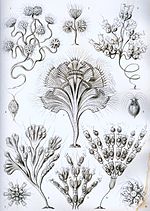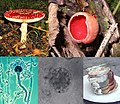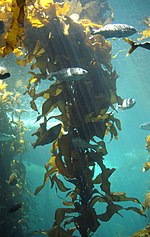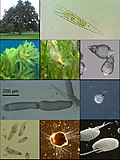The Stramenopiles, also called Heterokonts, are a clade of organisms distinguished by the presence of stiff tripartite external hairs. In most species...
33 KB (3,303 words) - 21:11, 29 July 2024
surrounding two singlets. Flagella may have hairs (mastigonemes), as in many Stramenopiles. Their interior is continuous with the cell's cytoplasm. Centrioles...
61 KB (6,089 words) - 12:28, 10 August 2024
and superphylum within Eukarya. They are currently grouped with the stramenopiles and Rhizaria among the protists with tubulocristate mitochondria into...
26 KB (2,694 words) - 23:49, 15 June 2024
(male gametes), some gymnosperms (cycads and Ginkgo, as male gametes) Stramenopiles: centric diatoms (male gametes), brown algae (zoospores and gametes)...
13 KB (1,350 words) - 03:43, 17 June 2024
groups Excavata Diaphoretickes Hacrobia Cryptista Rhizaria Alveolata Stramenopiles Plants Amorphea Amoebozoa Opisthokonta Animals Fungi Mesomycetozoea)...
125 KB (11,196 words) - 23:06, 13 August 2024
stramenochromes, are a group of algae. They are the photosynthetic stramenopiles, a group of eukaryotes, organisms with a cell nucleus, characterized...
41 KB (4,135 words) - 07:25, 16 May 2024
groups Excavata Diaphoretickes Hacrobia Cryptista Rhizaria Alveolata Stramenopiles Plants Amorphea Amoebozoa Opisthokonta Animals Fungi Mesomycetozoea)...
137 KB (14,760 words) - 07:00, 11 August 2024
the thraustochytrid stramenopiles. The QPX parasite is unicellular and possesses at least one flagellum, like most other stramenopile organisms. Thraustochytrids...
12 KB (1,410 words) - 01:04, 12 July 2024
diverse clade of eukaryotes, often considered a supergroup, that includes stramenopiles (heterokonts), alveolates, and rhizarians. It is a node-based taxon...
11 KB (1,083 words) - 20:45, 10 July 2024
groups Excavata Diaphoretickes Hacrobia Cryptista Rhizaria Alveolata Stramenopiles Plants Amorphea Amoebozoa Opisthokonta Animals Fungi Mesomycetozoea)...
24 KB (2,029 words) - 16:19, 14 August 2024
groups Excavata Diaphoretickes Hacrobia Cryptista Rhizaria Alveolata Stramenopiles Plants Amorphea Amoebozoa Opisthokonta Animals Fungi Mesomycetozoea)...
79 KB (6,233 words) - 21:17, 12 July 2024
groups Excavata Diaphoretickes Hacrobia Cryptista Rhizaria Alveolata Stramenopiles Plants Amorphea Amoebozoa Opisthokonta Animals Fungi Mesomycetozoea)...
95 KB (8,045 words) - 11:03, 11 August 2024
euglenid flagellates, while stiff hairs occur in stramenopile and cryptophyte protists. Stramenopile hairs are approximately 15 nm in diameter, and usually...
5 KB (419 words) - 13:54, 12 June 2023
different genera. Despite its appearance, kelp is not a plant but a stramenopile, a group containing many protists. Kelp grows in "underwater forests"...
42 KB (5,140 words) - 07:37, 30 July 2024
groups Excavata Diaphoretickes Hacrobia Cryptista Rhizaria Alveolata Stramenopiles Plants Amorphea Amoebozoa Opisthokonta Animals Fungi Mesomycetozoea)...
156 KB (16,493 words) - 15:57, 9 August 2024
Excavata, Opisthokonta and Stramenopiles, respectively), water molds (oomycetes) and hyphochytrids (both Stramenopiles) were formerly classified in...
201 KB (19,177 words) - 01:12, 28 July 2024
unrelated to true plants, being, instead, a photosynthetic, multicellular stramenopile protist of the SAR supergroup. The primary common name is derived from...
25 KB (2,728 words) - 23:13, 3 July 2024
phylogenetic lineage of fungus-like eukaryotic microorganisms within the Stramenopiles. They are filamentous and heterotrophic, and can reproduce both sexually...
20 KB (1,669 words) - 09:35, 2 May 2024
Chaetocerotaceae Coccolithophore Emiliania huxleyi Eustigmatophyte Frustule Stramenopile Nannochloropsis Navicula Prasinophyceae Raphidophyte Thalassiosira pseudonana...
77 KB (7,092 words) - 10:23, 2 June 2024
environmental significance through carbon fixation. Brown algae belong to the Stramenopiles, a clade of eukaryotic organisms that are distinguished from green plants...
59 KB (5,896 words) - 09:02, 10 August 2024
groups Excavata Diaphoretickes Hacrobia Cryptista Rhizaria Alveolata Stramenopiles Plants Amorphea Amoebozoa Opisthokonta Animals Fungi Mesomycetozoea)...
36 KB (2,526 words) - 10:26, 22 July 2024
British biologist Thomas Cavalier-Smith in 1981 to distinguish the stramenopiles, haptophytes, and cryptophytes. According to Cavalier-Smith, the kingdom...
26 KB (2,441 words) - 20:55, 15 May 2024
clade of three highly diverse lineages exclusively containing protists. Stramenopiles is a wide clade of photosynthetic and heterotrophic organisms that evolved...
94 KB (9,770 words) - 02:08, 26 July 2024
flagellates that consume bacteria, known as Bicosoecida, a basal lineage of Stramenopiles. Due to its small size it is described as a nanoflagellate. It is the...
13 KB (1,302 words) - 17:31, 25 April 2024
Nanney & McCoy 1976 (Alveolata), Thalassiosira pseudonana Cleve 1873 (Stramenopiles), and Arabidopsis thaliana (Linnaeus) Heynhold, 1842 (Archaeplastida)...
8 KB (689 words) - 01:07, 12 August 2024
encoded by the MAST2 gene MAST (MArine STramenopiles), clades of environmental DNA sequences from uncultured stramenopile microorganisms obtained in marine...
3 KB (443 words) - 21:09, 28 May 2024
groups Excavata Diaphoretickes Hacrobia Cryptista Rhizaria Alveolata Stramenopiles Plants Amorphea Amoebozoa Opisthokonta Animals Fungi Mesomycetozoea)...
24 KB (2,445 words) - 17:36, 19 July 2024
classification Domain: Eukaryota Clade: Diaphoretickes Clade: SAR Clade: Stramenopiles Phylum: Oomycota Order: Peronosporales Family: Peronosporaceae Genus:...
75 KB (7,618 words) - 10:13, 25 July 2024
which are found in coastal marine habitats. They are assigned to the Stramenopiles (heterokonts), a group which also contains kelp and various microalgae...
8 KB (752 words) - 22:28, 12 April 2024




























